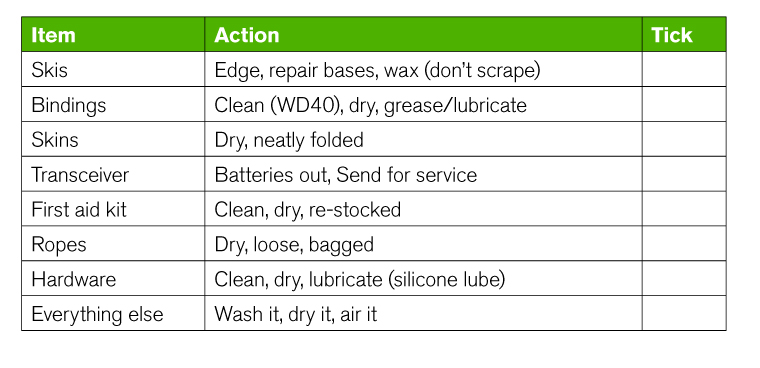How to store your ski gear this summer


When summer’s around the corner, chances are packing it in really means packing it up. Here are some hints, plus an even handier checklist, to make sure your clobber comes out in top nick when winter hits.
Hopefully your skis will have taken a hammering over the winter. Now is the time to give them a good overhaul, before those dry and grease-less components seize up in storage. It is also the best time to service the bases and tweak up the edges. When the next dump of snow arrives the last thing you want are rusty, blunt planks.
I like to give them some proper TLC and make sure the bases are top notch. This is the one time of year when I might put them over a belt to refresh the base texture. Then, when I wax them, I wax them heavy – a good thick coating, with enough wax to cover the metal edges. For once, I won’t scrape them: I’ll just leave them in their summer coat, fully protected. Store them not bound by tight ski straps, and ideally with tissue paper between them where the tips and tails touch. If you must strap them up, put the straps at the ends to leave any camber free and flexed.
Wind the din down to zero to take all the tension out. This will give those springs some time off over the summer and make sure they stay at the same rating for longer. Give the bindings a clean and lube, but don’t go nuts with solvent-rich, super-thin oils like WD40 as you’ll just wash the grease out. These are water displacers (WD – get it?) so they are great for cleaning up and drying out, but don’t think of them as a lubricant. Best to use a specialist binding grease, or a quality grease that works in the cold (like white lithium). If you have some good bike grease in the shed, get Googling to find out more about it, then use sparingly.
Follow our advice if you don’t want your skis to end up looking like this | Fotolia.com
I’m a huge fan of Lou Dawson at Wild Snow: if you’re short of time check out his blog as he’ll have done the work for you. Make sure every aspect of your skis and bindings (especially the nooks and crannies between the two) are dry; that’s where WD40 is really handy.
I like to set up a dehumidifier in my back hall/kit room and make an impromptu drying room for a couple of days. If you can arrange a similar set-up, you can do the following:
Take the batteries out of your transceiver(s). The fastest way to waste a couple of hundred quid is to find you have leaky batteries and corroded terminals next autumn. It will wreck your expensive device – so be pernickety about this one.
Send your transceiver off to be serviced, if you haven’t done so for a while. What do you mean, you haven’t ever? These units have a tendency to drift off frequency over time and can harbour all manner of hidden faults. It really is worthwhile sending them off for a service in line with the manufacturer’s instructions. Nope – I didn’t read them at the time either. The good news is that you can find them online.
Happy packing = happy turns as soon as the next snow falls. Good luck!
